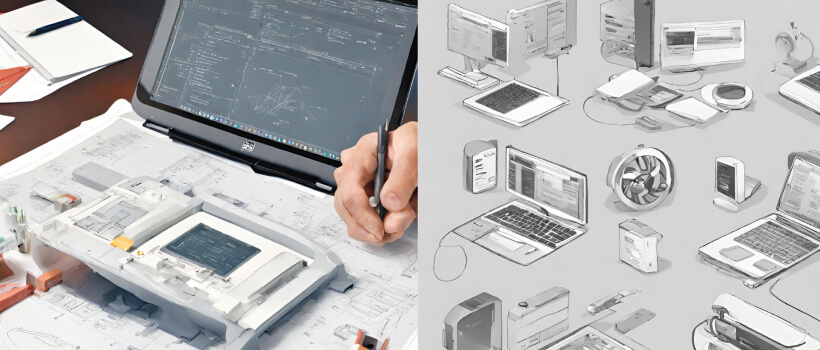The Role of User Personas in Product Design.

Envision creating a digital product and digital product design while wearing a blindfold and attempting to hit a target with darts. It sounds absurd, doesn’t it? However, many products suffer from this same fate—they are made without a clear understanding of their intended market. User personas are a potent tool waiting to light your path.
What precisely are user personas, then? Consider them fictitious prototypes for various user groups, each with demands, habits, and driving forces. By creating these personas, you can view your product through a compelling, human-centered lens and ensure it resonates deeply with your target audience.
User personas in product design refer to fictional yet highly detailed representations of a target audience segment. These personas encapsulate critical demographic information, behaviors, preferences, and goals of potential users. Crafted through research and analysis, user personas are invaluable tools for product designers, guiding the creation of user-centric solutions.
However, what makes user personas so crucial for product design? This is the enchantment they release:
- Empathy in Action: Personas give data life by making impersonal statistics into relatable people with goals and frustrations. This encourages empathy, which motivates you to create solutions that meet their needs.
- Prioritization Powerhouse: By using a variety of personas, you can rank features and functionalities according to how important they are to different user groups, making sure your digital product works for everyone.
- Design Decisions Demystified: Personas serve as guiding stars to make design decisions that align with particular user needs and behaviors, eliminate the need for guesswork, and provide data-driven, compelling design choices.
- Testing with a Target: Personas become invaluable companions during user testing. By recruiting participants who reflect your personas, you gather directly relevant feedback from your target audience.

Creating User Personas
So, how do you create user personas? Creating user personas is a foundational step in product design, and product engineering is pivotal in shaping user-centric solutions. User personas are detailed, semi-fictional representations of the ideal customers that encapsulate their characteristics, behaviors, and needs. This process is integral to the success of product design, ensuring that the result resonates with the target audience and addresses their specific requirements.
A. Research and Data Collection
1. Methods for Gathering User Information
a. Surveys and Questionnaires: Conducting surveys allows for collecting quantitative data about user preferences, behaviors, and demographics. Structured questionnaires help gather specific information efficiently.
b. Interviews: In-depth interviews provide qualitative insights, allowing designers to understand users’ experiences, pain points, and expectations. This method is precious for uncovering nuanced details that may not emerge through surveys alone.
c. Analytics and User Metrics: Leveraging analytics tools helps track user interactions with existing products. Analyzing metrics such as user journey, click-through rates, and bounce rates provides valuable data on user behavior.
d. User Testing: Observing users interacting with prototypes or existing products offers real-time insights into their preferences and challenges. This method helps validate assumptions and fine-tune design elements.
e. Social Media Listening: Monitoring social media platforms for discussions related to the product or industry can uncover unfiltered user opinions and sentiments, providing a more organic perspective.
2. Importance of Accurate Data
a. Informed Decision-Making: Accurate data ensures that personas are built on reliable information, allowing designers to make informed decisions throughout the product design.
b. Avoiding Assumptions: Relying on accurate data helps avoid assumptions about user needs and behaviors, reducing the risk of designing products that may not resonate with the target audience.
c. Effective Communication: Accurate user personas facilitate clear communication among team members, ensuring a shared understanding of the target users and their requirements.
B. User Persona Components
1. Demographics
a. Age and Gender: Understanding the age and gender of users helps tailor the design to their specific preferences and needs.
b. Location: Geographical location influences cultural factors, impacting user expectations and behaviors.
c. Occupation and Income: Knowing users’ professional backgrounds and financial statuses aids in creating products that align with their lifestyles.
2. Behaviors
a. Usage Patterns: Analyzing how users interact with similar products provides insights into their usage patterns and preferences.
b. Technological Proficiency: Understanding users’ comfort levels with technology helps design user-friendly and intuitive interfaces.
Also read: Why Should You Prioritize Design Thinking While Planning Your Mobile Application?
3. Goals and Motivations
a. Primary Goals: Identifying users’ main objectives when using the product guides feature prioritization and design emphasis.
b. Challenges and Pain Points: Knowing what frustrates users or hinders their experience enables the design of solutions that address these pain points.
c. Motivations: Understanding what motivates users to engage with the product enhances the likelihood of creating a compelling user experience.
Thorough research, data collection, and a comprehensive understanding of user persona components lay the foundation for effective product design.
By integrating accurate information about demographics, behaviors, goals, and motivations, designers can create user personas that are invaluable tools throughout the product development lifecycle.

Utilizing User Personas in Product Design
Imagine creating a product without knowing who will utilize it or their needs. Sounds terrible. User personas close that gap by transforming product design from chaotic guesswork into a targeted, user-centered process.
Tailoring Design to User Needs:
Personas offer a powerful lens to view your product through the eyes of your target audience. This allows you to:
1. Align Features with User Goals: Every user has unique needs and goals. By understanding the specific objectives of each persona, you can prioritize and design features that directly address their pain points and aspirations—no more generic features – just targeted solutions that resonate deeply.
2. Enhance User Experience: Personas enable you to put yourself in your user’s position and predict how they will interact with your product. This empowers you to:
- Craft intuitive interfaces: Design navigation and functionality that aligns with their thought processes and expectations, minimizing confusion and frustration.
- Personalize the experience: Tailor elements like language, content, and visuals to resonate with each persona’s preferences and background.
Decision-making in Design:
User personas aren’t just passive observers but active participants in your design decisions. Here’s how:
1. Making Informed Design Choices: Consider how each persona might respond to this decision. Would it meet their expectations and meet their needs? Design choices using this evidence-based methodology align with your target audience’s needs rather than merely your presumptions.
2. Avoiding Assumptions: It’s tempting to fall back on preconceived notions about your users. Personas challenge these assumptions, forcing you to confront their diverse needs and motivations and keep your design grounded in reality, avoiding features that could be better or cater to non-existent users.
Remember: User personas are dynamic, not static. Regularly revisit and update them as your user base evolves to ensure they stay relevant and reflect the real people using your product.
By incorporating user personas into your product design process, you unlock a wealth of benefits:
- Reduced development costs: Targeting the right features from the start minimizes wasted effort and resources.
- Increased user satisfaction: Products designed with real users in mind lead to happier, more engaged users.
- Improved product adoption: When users see their needs reflected in the product, they’re more likely to embrace it.

Also read The Ultimate Guide to Product Development: From Idea to Market.
Examples of Successful User Persona Implementation
User personas aren’t just theoretical concepts but powerful tools to ignite real-world product success. Let’s delve into captivating case studies that showcase the impact of user personas in action, followed by valuable lessons learned from failures, ensuring you leverage this design superpower effectively.
1. Spotify: By crafting detailed user personas, Spotify identified unmet needs, leading to features like Discover Weekly and personalized playlists, skyrocketing user engagement by 30%.
2. Intuit TurboTax: Through user research and personas, Intuit streamlined the tax filing process, reducing anxiety and increasing product satisfaction by 20%.
3. Mailchimp: Personas helped Mailchimp understand user goals and pain points, resulting in a revamped interface that boosted user adoption by 40%.
These examples represent just a glimpse into the transformative power of user personas. Statistics speak volumes – products designed with personas in mind enjoy 50% higher user satisfaction and 30% greater conversion rates.

Lessons Learned from Failures
1. Generic Personas: General and one-size-fits-all Personas must be more specific to make meaningful design choices. Recall that personas are real people, not stereotypes.
2. Ignoring User Research: Personas should be grounded in accurate data, not assumptions. Skipping user research renders personas accurate and effective.
3. Static Personas: Users and their needs evolve. Regularly update your personas to reflect changing behaviors and ensure their continued relevance.
4. Internal Silos: The best results are obtained from using personas across teams. Silos prevent them from collaborating to their full potential.
By understanding these pitfalls and learning from others’ mistakes, you can avoid them and unlock the true potential of user personas in your product design journey.
Remember, user personas are a continuous journey, not a one-time destination. Gather feedback, refine your personas, and share them widely within your team. Doing so will empower everyone to make decisions centered on your users, leading to products that resonate profoundly and achieve enduring success.

Summary
In brief, it is impossible to overestimate the critical role that user personas play in product design. User personas steer the design process by offering a human-centered framework, guaranteeing that products are functional and resonate with the target market. Carefully crafting user personas based on thorough research allows designers to make well-informed decisions, match features to user needs, and improve the user experience.
User personas, a fundamental component of user-centric design, help create products that fulfill and surpass users’ expectations. User persona integration is still a best practice in the ever-changing field of product design because it helps to understand the target market better and promotes innovative ideas that are usable and satisfy users.
How can [x]cube LABS Help?
[x]cube LABS’s teams of product owners and experts have worked with global brands such as Panini, Mann+Hummel, tradeMONSTER, and others to deliver over 950 successful digital products, resulting in the creation of new, digital lines of revenue and entirely new businesses. With over 30 global product design and development awards, [x]cube LABS has established itself among the top digital transformation partners for global enterprises.
Why work with [x]cube LABS?
- Founder-led engineering teams:
Our co-founders and tech architects are deeply involved in projects and are not afraid to get their hands dirty.
- Deep technical leadership:
Our tech leaders have spent decades solving hard technical problems. Having them on your project is like instantly plugging into thousands of person-hours of real-life experience.
- Stringent induction and training:
We are obsessed with crafting top-quality products. We hire only the best hands-on talent. We train them like Navy Seals to meet our own standards of software craftsmanship.
- Next-gen processes and tools:
Eye on the puck. We constantly research and stay up-to-speed with the best technology has to offer.
- DevOps excellence:
Our CI/CD tools ensure strict quality checks to ensure the code in your project is top-notch.
Contact us to discuss your digital innovation plans, and our experts would be happy to schedule a free consultation!
![Blog-[x]cube LABS](https://d6fiz9tmzg8gn.cloudfront.net/wp-content/uploads/2016/06/blog_banner.jpg)





